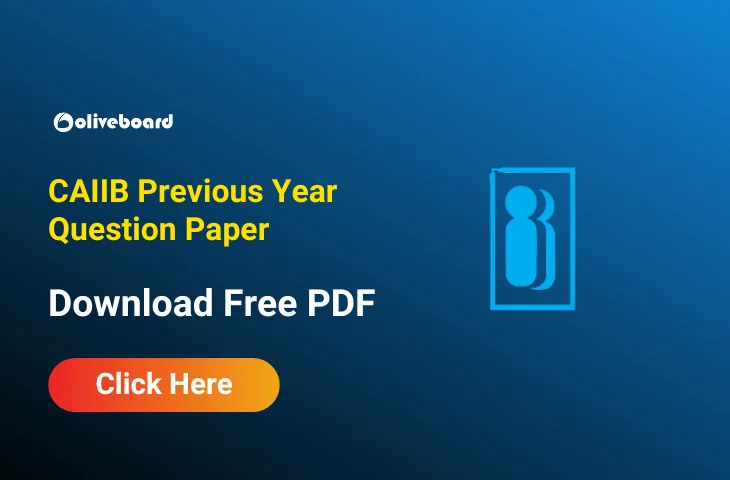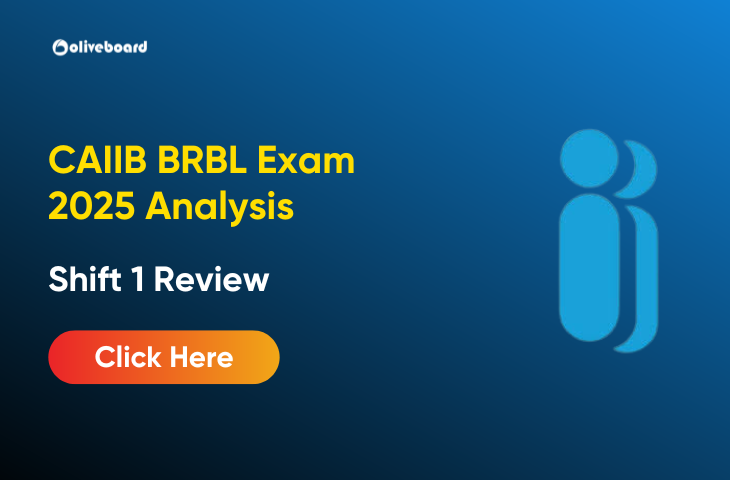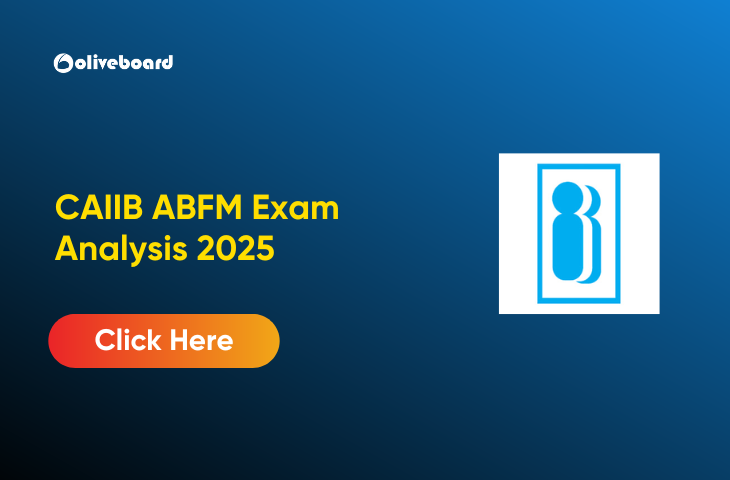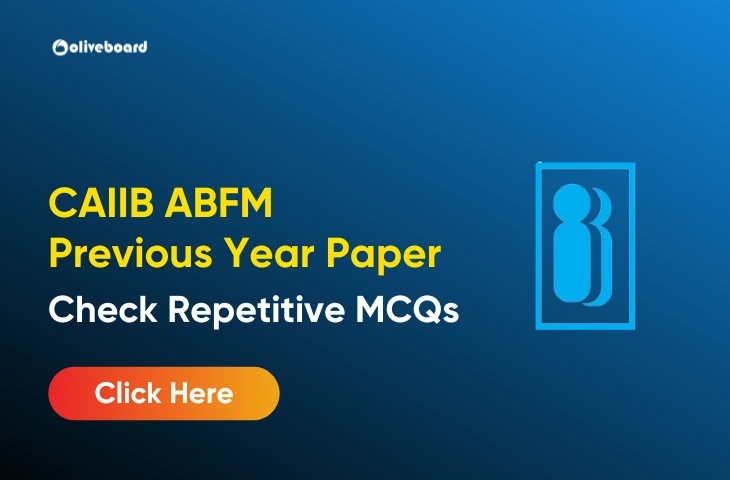CAIIB ABFM Previous Year Paper
The CAIIB ABFM exam is a important part of the CAIIB certification. CAIIB exam tests your knowledge of banking management, finance, and business strategy. A smart way to prepare for the CAIIB ABFM exam is by practicing previous year papers. By doing this, you can understand the exam pattern, types of questions, and the level of difficulty. In this article, we will discuss the CAIIB ABFM previous year paper and highlight the most repetitive MCQs that often appear in the exam.
Why is Practicing CAIIB ABFM Previous Year Papers Important?
Before we dive into the details of the CAIIB ABFM previous year paper, let’s first understand why practicing these papers is crucial for your success:
- Understanding the Exam Pattern: Previous year papers give you a clear idea of the exam format, including the number of questions, time limits, and marking scheme.
- Recognizing Repetitive Topics: These papers help you identify which topics are frequently asked. Focusing on these topics increases your chances of scoring well in the exam.
- Boosting Confidence: Regular practice improves your time management, helps you stay confident, and reduces exam-related stress.
- Self-Assessment: Reviewing your answers after practicing these papers helps you assess your strengths and weaknesses. This helps you focus on areas that need improvement.
CAIIB ABFM Previous Year Paper – MCQs
1. Which of the following is a key objective of asset liability management (ALM)?
- A) Maximizing net interest income
- B) Reducing operational costs
- C) Matching the maturity of assets and liabilities
- D) Improving customer service
Answer: C) Matching the maturity of assets and liabilities
2. Which of the following is a significant characteristic of a bank’s capital adequacy ratio (CAR)?
- A) It indicates the level of profit
- B) It helps in measuring the bank’s risk exposure
- C) It calculates operational costs
- D) It calculates liquidity
Answer: B) It helps in measuring the bank’s risk exposure
3. What does the term ‘loan loss provisioning’ refer to?
- A) The practice of preparing for loan repayments
- B) Allocating funds to cover potential loan defaults
- C) Reducing loan interest rates
- D) Minimizing loan term lengths
Answer: B) Allocating funds to cover potential loan defaults
4. Which of the following is NOT part of the Basel III framework?
- A) Liquidity Coverage Ratio (LCR)
- B) Capital Conservation Buffer
- C) Leverage Ratio
- D) Cash Reserve Ratio (CRR)
Answer: D) Cash Reserve Ratio (CRR)
5. The term ‘Duration’ in risk management refers to:
- A) A measure of the time it takes to liquidate a security
- B) The time taken by a borrower to repay the loan
- C) The interest rate sensitivity of a bond
- D) The total maturity of an investment
Answer: C) The interest rate sensitivity of a bond
6. Which of the following is a major factor that affects the cost of funds for a bank?
- A) Deposit growth
- B) Regulatory costs
- C) Interest rates in the market
- D) Competition from other banks
Answer: C) Interest rates in the market
7. What is the primary purpose of financial derivatives in a bank’s portfolio?
- A) To diversify the portfolio risk
- B) To increase profitability through speculation
- C) To hedge against interest rate or currency risk
- D) To improve the liquidity position
Answer: C) To hedge against interest rate or currency risk
8. What does the term ‘Net Interest Margin (NIM)’ represent?
- A) Total income generated from lending activities
- B) The spread between interest income and interest expense
- C) The total profit margin after taxes
- D) The percentage of the bank’s capital invested in loans
Answer: B) The spread between interest income and interest expense
9. Which of the following is a method used for managing market risk?
- A) Hedging
- B) Cost-cutting measures
- C) Customer diversification
- D) Increasing loan tenure
Answer: A) Hedging
10. Which ratio is used to assess a bank’s liquidity position?
- A) Return on Assets (ROA)
- B) Debt to Equity Ratio
- C) Loan to Deposit Ratio (LDR)
- D) Current Ratio
Answer: C) Loan to Deposit Ratio (LDR)
11. Which of the following is a key component of credit risk management?
- A) Setting interest rates on loans
- B) Properly analyzing the borrower’s creditworthiness
- C) Creating customer service initiatives
- D) Reducing operating expenses
Answer: B) Properly analyzing the borrower’s creditworthiness
12. Which of the following risks does NOT typically affect the treasury management function?
- A) Market risk
- B) Liquidity risk
- C) Credit risk
- D) Operational risk
Answer: D) Operational risk
13. The ‘Risk Adjusted Return on Capital (RAROC)’ is used to:
- A) Determine the profitability of a loan
- B) Assess the risk taken for earning a particular return
- C) Identify the creditworthiness of borrowers
- D) Calculate the loan default rate
Answer: B) Assess the risk taken for earning a particular return
14. Which of the following is a common financial instrument used for liquidity management by banks?
- A) Mortgage-backed securities
- B) Certificate of Deposit (CD)
- C) Treasury bills
- D) Equity shares
Answer: C) Treasury bills
15. The process of identifying, assessing, and managing all types of risks a bank faces is known as:
- A) Risk assessment
- B) Credit management
- C) Risk management
- D) Portfolio management
Answer: C) Risk management
16. What is the main aim of a bank’s treasury function?
- A) To monitor the quality of the bank’s loan portfolio
- B) To manage the bank’s funds efficiently and reduce risks
- C) To assess customer creditworthiness
- D) To manage the customer service experience
Answer: B) To manage the bank’s funds efficiently and reduce risks
17. Which of the following is a financial instrument used by banks for hedging foreign exchange risk?
- A) Forward contracts
- B) Equity shares
- C) Savings accounts
- D) Term loans
Answer: A) Forward contracts
18. The ‘Liquidity Coverage Ratio (LCR)’ introduced under Basel III is aimed at ensuring:
- A) Sufficient capital reserves for banks
- B) Sufficient liquidity to meet short-term obligations
- C) Proper management of interest rate risks
- D) Adequate profitability in bank operations
Answer: B) Sufficient liquidity to meet short-term obligations
19. Which of the following is a major component of the capital structure of a bank?
- A) Equity capital
- B) Customer deposits
- C) Borrowed funds
- D) Cash reserves
Answer: A) Equity capital
20. The term ‘Stress Testing’ in risk management refers to:
- A) Identifying potential fraud activities
- B) Simulating adverse economic conditions to test a bank’s resilience
- C) Determining the maximum loan that can be issued
- D) Calculating the risk-weighted assets of the bank
Answer: B) Simulating adverse economic conditions to test a bank’s resilience
21. What is the role of the ‘Alm Committee’ in banks?
- A) To review asset quality
- B) To ensure proper management of market risks
- C) To monitor interest rate and liquidity risk
- D) To oversee credit policies
Answer: C) To monitor interest rate and liquidity risk
22. What is the purpose of a bank’s ‘Investment Portfolio’?
- A) To hold loans and advances for customers
- B) To manage the bank’s liquidity and generate returns
- C) To monitor customers’ savings accounts
- D) To track cash reserves for emergency use
Answer: B) To manage the bank’s liquidity and generate returns
23. Which of the following is an example of a ‘derivative’ financial instrument?
- A) Fixed deposits
- B) Mutual funds
- C) Options contracts
- D) Savings accounts
Answer: C) Options contracts
24. What is the key focus of a bank’s ‘Risk Management Framework’?
- A) Identifying and mitigating financial, operational, and reputational risks
- B) Maximizing profit margins
- C) Providing loans to customers
- D) Marketing the bank’s services to potential clients
Answer: A) Identifying and mitigating financial, operational, and reputational risks
25. Which of the following is a key aspect of liquidity risk management in banks?
- A) Diversifying the loan portfolio
- B) Ensuring that the bank can meet its short-term obligations
- C) Increasing capital reserves
- D) Reducing credit risk exposure
Answer: B) Ensuring that the bank can meet its short-term obligations
26. Which of the following risks is associated with the failure of a borrower to repay a loan?
- A) Credit risk
- B) Market risk
- C) Liquidity risk
- D) Operational risk
Answer: A) Credit risk
27. Which of the following financial ratios measures the profitability of a bank?
- A) Return on Equity (ROE)
- B) Loan-to-Deposit Ratio (LDR)
- C) Capital Adequacy Ratio (CAR)
- D) Liquidity Coverage Ratio (LCR)
Answer: A) Return on Equity (ROE)
28. In the context of a bank’s financial statements, ‘Assets’ refer to:
- A) Bank’s liabilities and equity
- B) Only cash and deposits
- C) Resources owned by the bank which generate income
- D) Deposits and savings accounts
Answer: C) Resources owned by the bank which generate income
29. Which of the following is used to manage interest rate risk in a bank’s portfolio?
- A) Currency swaps
- B) Interest rate swaps
- C) Equity investments
- D) Cash reserves
Answer: B) Interest rate swaps
30. Which ratio is used to assess the capital adequacy of a bank?
- A) Capital Adequacy Ratio (CAR)
- B) Liquidity Coverage Ratio (LCR)
- C) Loan-to-Deposit Ratio (LDR)
- D) Net Interest Margin (NIM)
Answer: A) Capital Adequacy Ratio (CAR)
31. What is ‘Operational Risk’?
- A) Risk of losses from system failures or human error
- B) Risk of market price fluctuations
- C) Risk of a borrower defaulting on loans
- D) Risk of losing capital due to economic downturns
Answer: A) Risk of losses from system failures or human error
32. Which of the following types of loans involves higher risk due to the absence of collateral?
- A) Secured loans
- B) Unsecured loans
- C) Personal loans
- D) Home loans
Answer: B) Unsecured loans
33. Which of the following financial instruments is most commonly used for hedging against currency risk?
- A) Options
- B) Forward contracts
- C) Fixed deposits
- D) Mutual funds
Answer: B) Forward contracts
34. Which of the following is NOT a part of a bank’s financial strategy?
- A) Asset-liability management
- B) Risk management framework
- C) Performance-based compensation for employees
- D) Customer acquisition and retention
Answer: C) Performance-based compensation for employees
35. The term ‘Credit Rating’ refers to:
- A) The assessment of a borrower’s repayment ability
- B) The interest rate charged on a loan
- C) The total capital reserves of a bank
- D) The liquidity position of a bank
Answer: A) The assessment of a borrower’s repayment ability
36. Which type of risk arises due to fluctuations in the value of market assets?
- A) Credit risk
- B) Market risk
- C) Liquidity risk
- D) Operational risk
Answer: B) Market risk
37. What does the ‘Gearing Ratio’ measure in a bank’s financial analysis?
- A) The relationship between debt and equity capital
- B) The proportion of customer deposits to loans
- C) The profitability of investments
- D) The liquidity position of the bank
Answer: A) The relationship between debt and equity capital
38. Which of the following financial instruments is used by banks to manage interest rate risk?
- A) Interest rate swaps
- B) Bonds
- C) Savings accounts
- D) Fixed deposits
Answer: A) Interest rate swaps
39. The ‘Capital Conservation Buffer’ under Basel III aims to:
- A) Increase profitability
- B) Provide a cushion during financial stress
- C) Manage operational costs
- D) Reduce risk exposure
Answer: B) Provide a cushion during financial stress
40. Which of the following is NOT a major category of risks faced by a bank?
- A) Credit risk
- B) Market risk
- C) Political risk
- D) Transaction risk
Answer: C) Political risk
41. Which type of financial asset has the lowest risk?
- A) Treasury bills
- B) Corporate bonds
- C) Equities
- D) Mortgages
Answer: A) Treasury bills
42. What does ‘Liquidity Risk’ refer to?
- A) The risk of a borrower failing to repay a loan
- B) The risk of being unable to meet short-term financial obligations
- C) The risk of adverse market movements
- D) The risk of fraud or system failure
Answer: B) The risk of being unable to meet short-term financial obligations
43. Which of the following is a common method used by banks to measure credit risk?
- A) Credit score analysis
- B) Risk-weighted asset calculation
- C) Net Interest Margin (NIM)
- D) Profitability analysis
Answer: A) Credit score analysis
44. What is the primary objective of the ‘Capital Adequacy Ratio (CAR)’ for banks?
- A) To increase the bank’s profitability
- B) To measure the bank’s risk-taking ability
- C) To track the interest income
- D) To monitor loan performance
Answer: B) To measure the bank’s risk-taking ability
45. In the context of risk management, ‘hedging’ is primarily used to:
- A) Reduce interest rate risk
- B) Increase capital reserves
- C) Enhance customer service
- D) Maximize returns on investments
Answer: A) Reduce interest rate risk
46. Which of the following ratios helps in assessing the riskiness of a bank’s lending operations?
- A) Capital Adequacy Ratio
- B) Loan-to-Deposit Ratio
- C) Non-Performing Assets (NPA) Ratio
- D) Return on Equity
Answer: C) Non-Performing Assets (NPA) Ratio
47. What is the key risk associated with foreign exchange transactions?
- A) Operational risk
- B) Currency risk
- C) Credit risk
- D) Systemic risk
Answer: B) Currency risk
48. What is the primary purpose of the ‘Stress Test’ in banking?
- A) To evaluate the bank’s financial stability under adverse conditions
- B) To determine the profitability of the bank
- C) To assess the risk of default by borrowers
- D) To monitor the capital adequacy ratio
Answer: A) To evaluate the bank’s financial stability under adverse conditions
49. Which of the following is an example of market risk?
- A) A decrease in the value of a bank’s investments due to interest rate changes
- B) A borrower failing to repay a loan
- C) Operational errors leading to losses
- D) Inability to meet liquidity obligations
Answer: A) A decrease in the value of a bank’s investments due to interest rate changes
50. Which of the following is a common financial ratio used to evaluate the performance of a bank?
- A) Return on Assets (ROA)
- B) Loan-to-Deposit Ratio (LDR)
- C) Interest Rate Swaps
- D) Gross Profit Margin
Answer: A) Return on Assets (ROA)
Most Repetitive MCQs in CAIIB ABFM Exam
While the CAIIB ABFM exam covers a wide range of topics related to banking, management, and finance, certain concepts and questions are asked repeatedly. Here are some of the most repetitive MCQs in the CAIIB ABFM previous year paper:
1. Banking Regulations and Compliance
Questions on banking regulations and compliance form a significant portion of the CAIIB ABFM exam. Some of the key areas frequently tested are:
- Banking laws and Acts
- RBI guidelines and their application
- Risk management frameworks
2. Financial Management in Banks
Understanding the financial operations of a bank is essential for the CAIIB ABFM exam. The following topics are often tested:
- Capital adequacy ratios
- Profit and loss management
- Balance sheet structure
3. Strategic Management in Banking
Strategic management is another frequently tested area. Some common questions in this section focus on:
- Strategic decision-making processes
- SWOT analysis
- Business growth strategies
4. Risk Management and Internal Controls
Risk management is a critical area in the CAIIB ABFM exam. Here are some topics frequently asked:
- Credit risk and its mitigation
- Operational risk
- Market risk management
5. International Banking and Finance
In today’s globalized world, international banking has become an important aspect of banking operations. Key topics covered in previous year papers include:
- Foreign exchange markets
- International trade and finance
- Global financial systems
CAIIB ABFM Important Topics and Their Frequency
| Topic | Frequency in Previous Year Papers |
| Banking Regulations and Compliance | High |
| Financial Management in Banks | Medium |
| Strategic Management in Banking | Medium |
| Risk Management and Internal Controls | High |
| International Banking and Finance | Low to Medium |
Final Thoughts
In conclusion, practicing CAIIB ABFM previous year papers is one of the most effective ways to prepare for the exam. By focusing on the repetitive MCQs, you can boost your chances of scoring well. Always remember to analyze your performance, practice regularly, and prioritize important topics. With consistent effort and the right strategy, you can ace the CAIIB ABFM exam.
- CAIIB BRBL Questions with Detailed Solutions and Answers

- CAIIB Previous Year Question Paper, Download Free PDF

- CAIIB Electives Exam Analysis 2025, December All Paper Review

- CAIIB BRBL Exam Analysis 2025, December Cycle Review

- CAIIB ABFM Exam Analysis 2025, 13th December Review

- CAIIB BFM Exam Analysis 2025, 7th December Difficulty Level


Hello there! I’m a dedicated Government Job aspirant turned passionate writer & content marketer. My blogs are a one-stop destination for accurate and comprehensive information on exams like Regulatory Bodies, Banking, SSC, State PSCs, and more. I’m on a mission to provide you with all the details you need, conveniently in one place. When I’m not writing and marketing, you’ll find me happily experimenting in the kitchen, cooking up delightful treats. Join me on this journey of knowledge and flavors!
